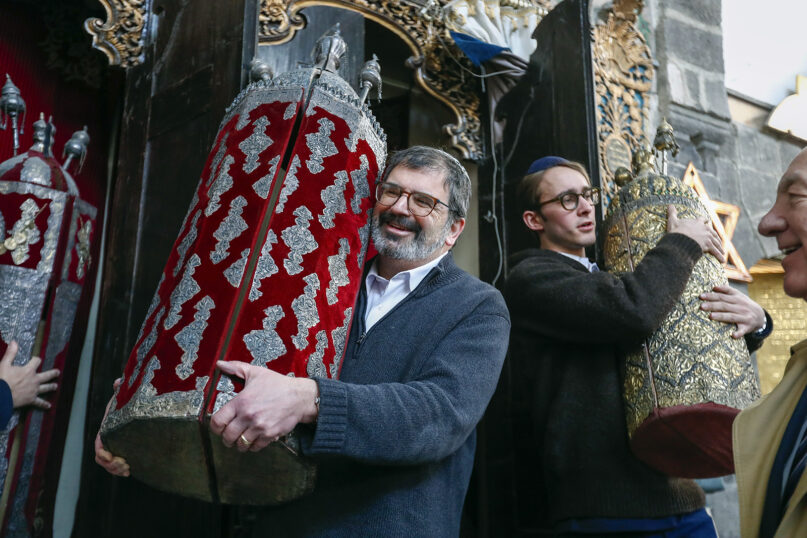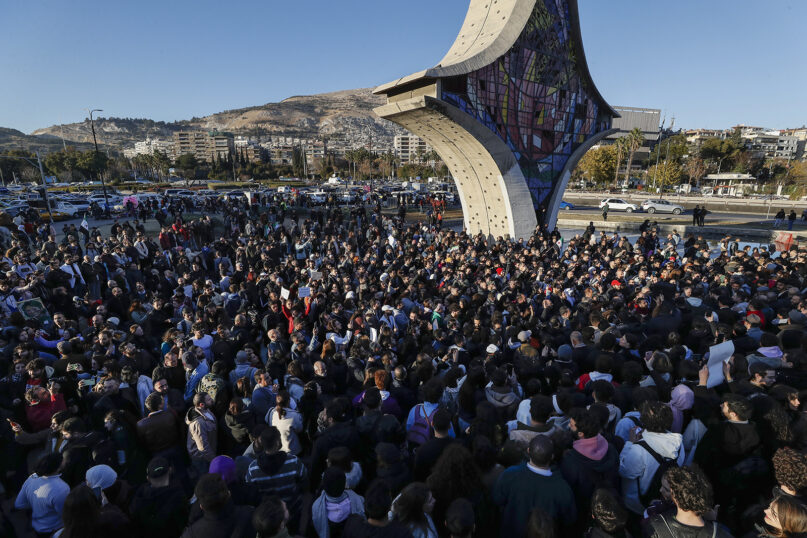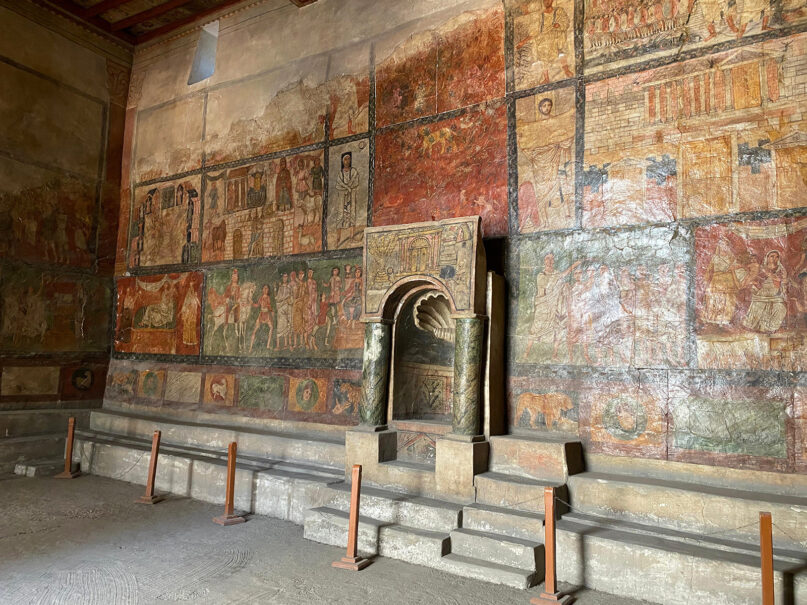
(RNS) — As Jews around the world were preparing for the new Hebrew year last week, Rabbi Asher Lopatin stood in Damascus looking at a different type of new beginning.
While he visited Syria for the first time in February and a couple Syrian community rabbis have gone on their own, Lopatin’s September trip marked the first significant American Jewish leadership visit in recent memory. He led 13 people to historical Jewish sites in Syria and to meet with representatives of the new Syrian government over two days, in the hopes of improving relations with the global Jewish community and Israel, its neighbor to the south.
“Rosh Hashanah is about new beginnings, and a new world,” said Lopatin, who is director of community relations at the Jewish Federation of Greater Ann Arbor in Michigan. “And definitely Jews going to Syria, as Jews who are proud Jews … there is a very new beginning here.”
Jews lived in the lands that now make up Syria since biblical times, with large, ancient communities in areas like Damascus, Aleppo and Qamishli. But millennia of Jewish life there ended in the 1990s, with the last major exodus of Syrian Jewry. Today, only around half a dozen elderly Jews are believed to remain.
Syria and Israel have been in conflict since Israel’s founding in 1948, and relations further deteriorated following the 1967 Six-Day War, when Israel captured and occupied the Golan Heights, which Syria still claims. Following the establishment of the state of Israel, mass riots in Syria killed dozens of Jews and burned homes, shops and synagogues. Jews who remained were barred from government service and banned from owning passports, driver’s licenses and communication equipment and from embarking on domestic and international travel. In 1992, nearly the last of Syria’s Jews were permitted to emigrate by then-President Hafez al-Assad’s government.
Today, over 100,000 Syrian Jews live in Israel and around 150,000 in the Americas, with large communities in Brooklyn, New York; New Jersey; Mexico City; Panama and Argentina.

FILE – Rabbi Asher Lopatin, left, and other American-Jewish visitors hold Torah scrolls at a synagogue in the old city of Damascus, Feb. 18, 2025. (AP Photo/Omar Sanadiki)
However, Lopatin said he is hopeful Syria’s new government under the leadership of President Ahmed al-Sharaa may be ready to turn over a new leaf.
“I’m really hoping that this government can thrive, Syria can thrive and can be pulled into the Western world — the world of tolerance, a world of freedom and respect for all religions and ethnic groups — and also a world of peace, hopefully peace with all its neighbors, including Israel,” Lopatin said. “So I was eager to bring a group of Jews, mostly American Jews, on a goodwill mission to Syria to really deepen the relationship between Jews and Syria and fulfill all those goals.”
The trip came at a time when both Syrian and Israeli officials have signaled the two states are nearing closing on a security agreement and halting decades of conflict. The new Syrian government has also indicated positive intent in embracing meetings, like with Lopatin’s group.
Since the fall of the Assad regime last December, Israel’s military has frequently intervened in Syria. The Israel Defense Forces has pushed well beyond the 1974 ceasefire line and operates across a buffer zone of hundreds of miles in southern Syria. Israel’s air force has continued to strike military bases and depots that it says could fall into the hands of groups like Hezbollah or Iranian allies. In July, Israel bombed the Syrian military headquarters in Damascus. And many credit Israel’s actions, crippling Hezbollah and Iran’s foreign influence, with allowing for an opening to topple Assad.

Historian Jill Joshowitz, left, and members of a Jewish delegation view paintings from the Dura-Europos Synagogue at the National Museum of Damascus, Sept. 16, 2025, during a trip to Syria. (Photo courtesy of Rabbi Mendy Chitrik, Alliance of Rabbis in Islamic States)
Accompanying Lopatin’s group was David Horovitz, editor-in-chief of English-language Israeli news outlet The Times of Israel. He chronicled the trip, describing visiting a city that, for decades, Israelis have viewed as an “enemy capital.”
The group was surprised to find a government and society open and eager to move beyond the past.
“I felt completely safe and at ease — many people waved and greeted us as I was traveling through the streets of Damascus wearing my black fedora,” Rabbi Mendy Chitrik, an Istanbul-based rabbi who is the founder and leader of Alliance of Rabbis in Islamic States, told RNS.
That isn’t to say they weren’t aware of agendas at play. Al-Sharaa’s government has been on a public-relations blitz, advocating for the removal of sanctions on syria and working to rid the government and its leader of past associations with Islamist and extremist groups.
In the 2000s, al-Sharaa spent five years in United States-run prisons in Iraq, including Abu Ghraib, for his association with al-Qaida, a group he joined around the 2003 invasion of Iraq. He was released in 2011, just days before the Syrian civil war began. He then founded the al-Nusra front, which many considered to be a Syrian arm of al-Qaida. As leader of al-Nusra, he fought under the nom de guerre “al-Jolani” meaning “of the Golan,” — the region Israel continues to occupy.
Al-Nusra operated until 2017, when it merged with other Sunni groups into the Hayat Tahrir al-Sham, which ousted the Assad regime in December 2024.

FILE – Syrian activists gather at the Umayyad Square during a protest to demand a secular state, in Damascus, Syria, Dec. 19, 2024. (AP Photo/Omar Sanadiki)
Despite assurances from al-Sharaa that his new Syrian government will not be another Taliban or Islamic State, and that it will respect the freedom and rights of Syrians of all cultures and faiths, many are watching with cautious apprehension.
Islam in Syria is divided between Sunni, Shia and Alawite sects. Two decades ago, it was home to more than 1.5 million Christians, but the number has dwindled to under 300,000 after years of civil war. Druze and Yazidi communities also make up a major part of Syria’s ethnic and religious mosaic.
Since the ouster of the Assad regime, the country has been far from free of sectarian violence. This summer, a Greek Orthodox church in Damascus was bombed, killing 24 Christians and wounding 60 more. In March, violence broke out in Syria’s coastal region and over 1,400 people were killed, many of whom after being asked “Are you Alawi?” according to Human Rights Watch, which also reported involvement of government forces and militias loyal to HTS. And in July, about 1,000 civilians were killed when clashes broke out between Druze militias and government forces in Syria’s south, which prompted Israel to intervene on the side of the Druze.
Lopatin noted that while his group came to represent the Jewish community, the Druze were not far from their minds. “Many of the meetings concerned the Druze and how they’re treated,” he said.
In New York last week for the United Nations General Assembly, al-Sharaa met with a wide swath of the Syrian diaspora, including 11 from New York’s Syrian Jewish community. During the meeting, one Syrian Jewish leader offered $100,000 to assist in the reconstruction of Syria, The Times of Israel reported. Al-Sharaa rejected the offer, but the gesture seemed well appreciated.
“The Syrian foreign minister (Asaad al-Shibani), who was sitting next to him, was also very happy,” said Joe Jajati, a Syrian Jew and founder of the Syria Mosaic Foundation, which helped organize the logistics for the trip on the ground in Syria. “They don’t need money, but it excited them to see this support.”
Jajati was born in Damascus in the 1990s, but immigrated to America as a young child. When the Assad regime fell, he jumped on the opportunity to return to the land of his birth and established the foundation to reach out to Syria’s diaspora.
“Our focus is on uniting Syria from all sides, all backgrounds,” Jajati told RNS. “We hope that there will be a time when Syrian Jews and any Syrians living outside of Syria can have some confidence to return, and they can speak to us and we can guide them and host them.”
Jajati has become a point person for many diaspora Syrians to connect with the heritage they left behind. Just days before Lopatin’s trip, the brass doors of a Damascus synagogue were stolen. Within hours, Jajati and the Damascus police department recovered them, and the delegation personally thanked the police chief during the visit.
The trip was also an opportunity to check on sites of Jewish heritage that had long been feared lost to the wider Jewish world.
“Praying Kaddish with a minyan (prayer quorum) at the gravesite of the famed Kabbalist Rabbi Chaim Vital was a very emotional experience, especially since his gravesite was desecrated a few months ago,” Chitrik said.
The group also visited the ruins of a synagogue in Jobar, a suburb of Damascus — a rebel stronghold bombed to rubble during the Assad regime.

Famous paintings from the Dura-Europos Synagogue are viewed during a Jewish delegation visit to the National Museum of Damascus, Sept. 16, 2025. (Photo courtesy of Jill Joshowitz)
One of the most groundbreaking revelations of the trip, however, was the fate of famed paintings of the ancient Dura-Europos Synagogue. Discovered in 1932, the synagogue is the remains of a Roman-era Jewish community that lived on the banks of the Euphrates River in eastern Syria. The entire complex was moved from the Syrian desert to the national Museum of Damascus, but whether the paintings had been damaged by the decadeslong civil war remained unknown. The site of Dura-Europos itself was occupied by the Islamic State, and much of the archaeological areas were vandalized, damaged and destroyed.
“The synagogue is important because it is the oldest and the only surviving example of Jewish figural biblical imagery as a painting,” said Jill Joshowitz, a Pittsburgh-based historian of Jewish visual culture. She became interested in the paintings in 2011 as a graduate student at Yeshiva University and completed a doctorate studying them in 2023 at New York University.
Amid the Syrian civil war, she never thought she would have the opportunity to see them in person — until Lopatin’s trip.
“It was surreal — I thought I would cry,” Joshowitz recalled after seeing the paintings. “… Just being there in the space gave me a much greater appreciation for the scale of what this ancient Jewish community had.”
Now in touch with her Syrian colleagues who protected the paintings for so long, she said she was excited about possibilities for future research.
Chitrik said that walking through the Damascus Jewish quarter, seeing synagogues, doorposts with mezuza markings and enjoying kosher hummus was “something one could only dream of in my childhood.” In modern Hebrew slang, “eating hummus in Damascus” is akin to the English idiom “when pigs fly,” — something never expected to happen.
“My hopes and prayers are that the new government of Syria will protect Jewish holy sites, and that religious, cultural and heritage ties not only continue, but flourish, in the new stable and free Syria,” he added.
